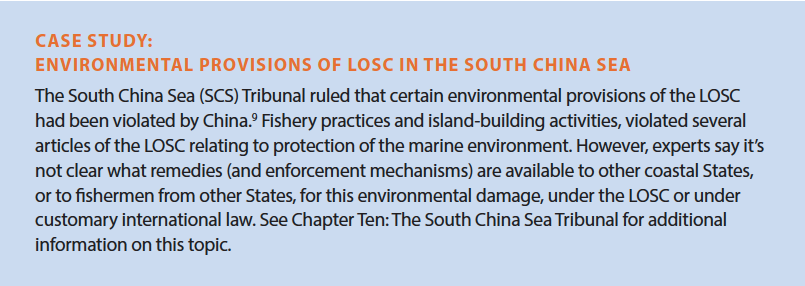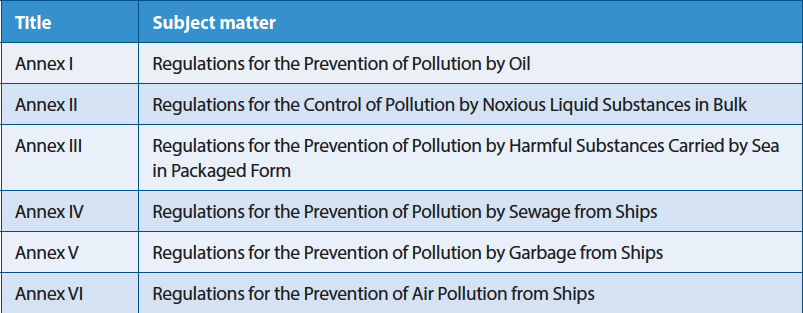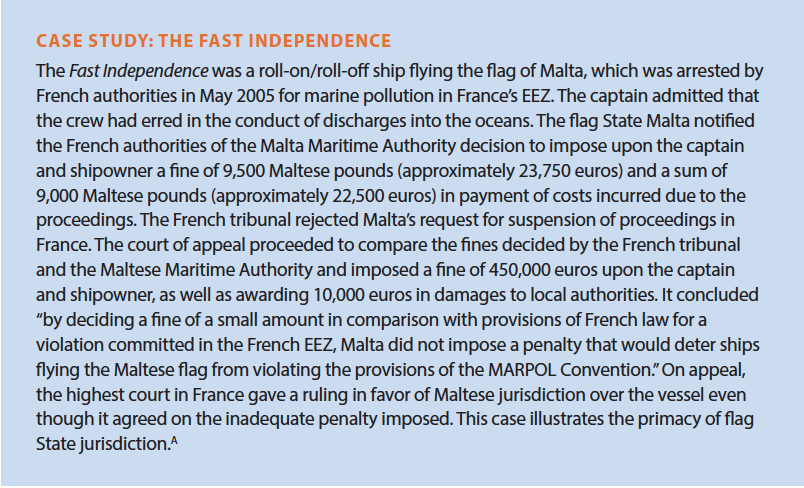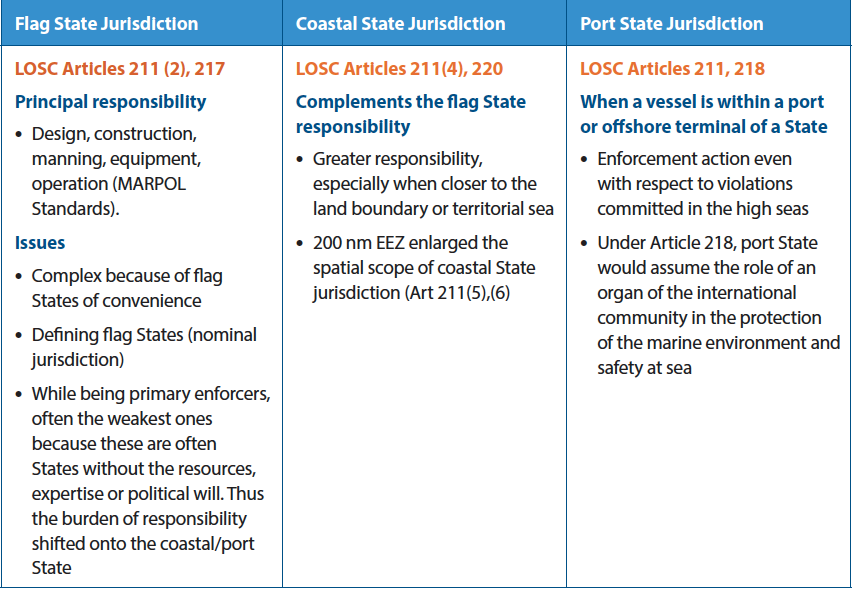Chapter 7: LOSC & the Environment
The LOSC and the Environment
Background
Origins
Through the leadership of States around the world, including the U.S., the LOSC made history as the first general global convention to protect the marine environment. The LOSC promotes an evidence-based approach to management and policy that facilitates coordination between economic, environmental, and military uses. For example, the Convention upholds every State’s right to exploit their natural resources as long as these actions are in accord with environmental preservation. Connecting the shores of every State, oceans today have greater economic, diplomatic, and scientific value than ever before. Through duties rather than obligations, the Convention encourages States to protect marine environments with its framework, enforcement mechanisms, and anti-pollution measures. Article 236 of the LOSC exempts warships and other sovereign immune vessels from the provisions described in this chapter. For more information about this topic see Chapter Five: Sovereign Immunity.
Value in an Interconnected World
Economists have quantified the worth of the oceans in ways that reveal their value to everyone. In 2015, the Worldwide Wildlife Fund (WWF) valued the oceans at $24 trillion.1 By protecting and preserving the marine environment, marine and deep sea industries, rare and threatened species, and healthy public waters, all States benefit. Events like the Exxon Valdez tanker spill, which spread an oil slick over 1,300 square miles off the coast of Alaska in 1989, reveal how modern environmental disasters, and the threats to marine assets, often take on a larger scope. While the oceans were once thought to be able to accommodate human waste indefinitely, they are now seen as finite and sensitive through events like the Fukushima radiation disaster, red tides, oil spills, and plastic gyres. Ahead of its time, the LOSC protects the environmental and economic assets of the oceans from large-scale disasters through the use of regional cooperation and pollution controls.
Life Systems
Beyond the economics, the LOSC matters because the marine environment sustains life on this planet. According to the State Department, “marine biodiversity and ecosystems are essential to the functioning of earth’s surface and atmosphere inhabited by living things and thus to the well-being of humans.”2 To ensure our own livelihoods, we have a duty to protect and not degrade the environment. Nature cannot necessarily replenish itself. As an example of irreversibility, human activity in the Pacific Ocean has caused damage to coral reefs, which are the essential home of many underwater ecosystems. By digging up coral reefs while building artificial islands, China, for example, has caused half of these reefs to decline.3 As world populations grow, strains on the environment will build. Global environmental cooperation and governance can lessen the impact on the marine environment through renewed responsibility and enforcement.
Environmental Framework
International Cooperation
The authors of Part VII the LOSC created basic rules for environmental preservation within an international framework based on global and regional cooperation, while respecting principles of State sovereignty. For more information about how the LOSC respects State sovereignty see Chapter Five: Sovereign Immunity. Leaving room for various kinds of implementation, the LOSC does not explicitly carve out the laws or duties of States and enforcement agencies.
Under the LOSC, States can cooperate either directly or through competent international organizations. Examples of Part VII’s architecture include general obligations to 1) protect and preserve the marine environment;4 2) control pollution of the marine environment from any source;5 3) prevent the introduction of alien species to marine environments;6 and 4) ensure that pollution from one State does not spread beyond the areas where they exercise sovereign rights.7
Communication Between States
The LOSC encourages communication between States to protect against spreading environment damage and mitigate pollution risks. As a scientific and diplomatic opportunity, States can share and receive information and data about the marine environment. This is an opportunity to strengthen international relations because joint contingency plans may reduce costs and increase shared responsibility. The LOSC gives financial and technical preference to developing States. This inclusive practice ensures that all States can complete and share periodic scientific reports on their marine environments and contribute to the development of pollution remedies. Under the LOSC, any additional rules, standards, or recommended practices, shall be science-based and developed between States directly or through competent international organizations.8
Responsibilities
The LOSC maintains a spirit of non-interference with State sovereignty. It is the State’s responsibility to measure its own impact on its environment and the environment of others. Rather than initiating a universal regime, the LOSC accepts that specific pollution laws will vary by region. The LOSC recommends that States take into account internationally agreed rules, standards, and recommended practices and procedures. By considering the unique economic and environmental capacity of each area, States can harmonize and create regional frameworks to serve the larger goal of reducing marine pollution. Whether the pollution originates from the shore or from seabed activities, national laws must be no less effective than international rules, standards, and recommended practices and procedures. The LOSC divides enforcement of the law between States. These differences can cause disagreements when States dispute environmental or territorial claims. For example, without clear remedies and enforcement mechanisms applicable to States and private fishermen, courts do their best to make fair rulings. These general provisions offer a holistic way of looking at the marine environment, State relationships to various parts of it, and relationships between States.
Pollution
The LOSC outlines six types of pollution: (1) land-based and coastal activities; (2) continental-shelf drilling; (3) potential seabed mining; (4) ocean dumping; (5) vessel- source pollution; and (6) pollution from or through the atmosphere.10 According to the National Oceanographic and Atmospheric Administration (NOAA), 80% of marine pollution begins on land.11 Dumping was a type of ocean based pollution that was popular in the 1950s and 1960s to dispose of waste produced by activities on land. The 1996 Protocol to the London Convention defined it as any pollution done by a vessel, aircraft, platform, or man-made structure at sea. Rules regulating land-based pollution remain weak at the global level. While the LOSC is relatively toothless with regard to international enforcement to prevent land based pollution, it does call for the prevention of land based pollution to be enforced by States themselves. Pollution maintains its classification as pollution whether its form is changed or if it is relocated. Without this provision, certain areas would likely become disproportionate dumping grounds. Looking ahead, the marine environment would benefit from new research on pollution management techniques, collaborations focused on institutionalizing compliance mechanisms, and a framework for land based pollution.
Vessel Source Pollution
Vessel source pollution, also known as ship-based pollution, involves the discharge of oil, oily residues, or other noxious substances into the sea by vessels. Although operational discharges from routine shipping activities release more oil than tanker spills, highly publicized accidents such as the Exxon Valdez spill pushed the international community in the direction of a treaty to deal with emergencies at sea. The LOSC and the International Convention for the Prevention of Pollution from Ships (MARPOL) provide the principal legal framework for the regulation of vessel source pollution.
International Convention for the Prevention of Pollution from Ships (MARPOL)
In 1973, the international community adopted MARPOL to cover pollution by oil, chemicals, harmful substances in packaged form, sewage, and garbage. Following a series of pollution incidents between 1973 and 1977, the International Maritime Organization (IMO), which regulates safety procedures for vessels traversing the oceans, adopted a Protocol in 1978 with measures related to tanker design and operation. The 1973 MARPOL and its 1978 Protocol are treated as a single instrument, generally referred to as MARPOL 73/78. Apart from accidental and operational pollution, MARPOL 73/78 aimed to deal with other forms of pollution from ships and therefore has annexes covering chemicals, harmful substances carried in packaged form, sewage, garbage, as well as a new Annex adopted in 1997 on the prevention of air pollution from ships. MARPOL 73/78 also had two Protocols dealing with reports on incidents involving harmful substances and arbitration. Annexes I and II are mandatory, while the other annexes are optional and States may opt out of these annexes.
MARPOL Convention Annexes
As of January 2017, 155 States representing 99.14 per cent of the world’s shipping tonnage are parties to Annexes I and II of MARPOL 73/78.12
Vessel Source Pollution Under The LOSC
Under the LOSC, vessel source pollution is regulated by flag States, coastal States, and port States. States have two kinds of jurisdiction: legislative (making national laws and regulations) and enforcement jurisdiction (ensuring compliance with national and international rules). While the rules for coordination between States have been laid out in detail in the LOSC, it is implementation that presents a complex challenge. An excerpt from a European marine pollution case is illuminating:
“Major incidents of pollution off the European coast have shown its vulnerability to the heavy maritime traffic along one of the world’s more important maritime routes. Among the frequent causes of pollution are violations of applicable laws and regulations or of international rules and standards relating to the prevention, reduction, and control of acts of pollution. Most of the illicit acts take place outside territorial waters, in the exclusive economic zones (EEZs) of the coastal States concerned. Coastal State navies attempt, in difficult conditions, to detect violations, gather the evidence, and bring the perpetrators to domestic courts to impose adequate penalties. Flag States often consent to coastal State proceedings or, alternatively, impose such adequate penalties through proceedings in their own courts. In some cases, however, flag States impose such nominal penalties that violations are not deterred, in which case the coastal State involved may attempt to retain jurisdiction.”13
Enforcement
Flag State Jurisdiction
The flag symbolizes the nationality of a vessel. By placing a ship on its register, a State undertakes the national and international responsibilities of a flag State in relation to that ship.14 Flag States have the primary duty to ensure that their ships comply with the standards accepted by the flag State under international law. The first two annexes to MARPOL are an example of such “international standards,” reflecting their widespread adoption by States. The LOSC declares that penalties provided for by the laws and regulations of flag States shall be “adequate” in severity to discourage violations wherever they occur.15
What Can Flag States Do?
Flag States make laws based upon international standards. One example would be CDEM standards, which are standards for construction, design, equipment and manning, and operation of vessels. Another example would be measures for
preventing accidents, dealing with emergencies, ensuring the safety of operations at sea, preventing both intentional and unintentional discharges.16
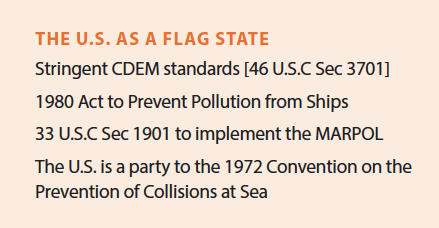 Flag States can also enforce laws and ensure compliance. This can include ensuring that vessels or ships do not sail unless they are “seaworthy” or in a good condition to sail. States can also ensure that vessels carry necessary certificates and conduct periodic inspections. If a vessel violates rules and standards, there is a duty to immediately investigate and initiate action where necessary. There is also a duty to inform the IMO and requesting States of the actions taken.17
Flag States can also enforce laws and ensure compliance. This can include ensuring that vessels or ships do not sail unless they are “seaworthy” or in a good condition to sail. States can also ensure that vessels carry necessary certificates and conduct periodic inspections. If a vessel violates rules and standards, there is a duty to immediately investigate and initiate action where necessary. There is also a duty to inform the IMO and requesting States of the actions taken.17
The enforcement jurisdiction of a flag State is borderless and extends to wherever the vessel sails. Unfortunately, flag States are often not major maritime States, but rather States with liberal tax rules and a relatively light regulatory touch structured to make them attractive to ship owners. This combination of insufficient resources and expertise along with a lack of political will often limits their willingness to initiate legislation and capacity to enforce applicable environmental rules (see the case study of the Liberian Registry below).18 Less scrupulous operators register their ships under the flags of such lenient States, leading to the “flags of convenience” problem in marine environmental pollution enforcement. To fill the gap, coastal and port States have been given additional legislative and enforcement powers.
Coastal State Jurisdiction
Coastal States exercise jurisdiction complementing flag State jurisdiction to prevent marine pollution from foreign vessels entering their territorial seas and EEZs. This is different from flag State jurisdiction because the authority is derived from territorial sovereignty and control over maritime boundaries. Coastal State jurisdiction extends to the 200 nm EEZ and States may adopt additional environmental standards for special areas within the EEZ.20 The exercise of enforcement measures depends on the seriousness of damage inflicted on the coastal State’s interests.
What Can Coastal States Do?
Coastal States can make laws that only permit such design, construction, equipment, and manning standards that give effect to international standards.21
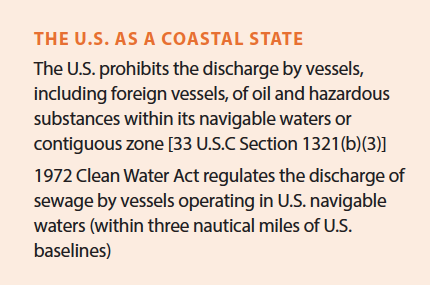 Coastal States can also enforce laws by instituting legal proceedings in case of violation of laws and regulations by a vessel voluntarily entering its ports or offshore terminals.22In the territorial sea, they can conduct physical inspections, initiate court proceedings, and detain vessels if necessary. In the EEZ, they can ask for relevant information with respect to violations, physically inspect vessels when a violation leads to substantial discharge causing or threatening significant pollution of the marine environment and when a vessel has refused to give information, proceedings can be initiated in the case of clear objective evidence. There are safeguards against the exercising of enforcement powers by coastal States. For example, powers of enforcement against foreign vessels may only be exercised by government ships and aircraft23 and penalties are limited to monetary penalties.24 Proceedings to impose penalties are to be suspended when a flag State imposes such penalties.
Coastal States can also enforce laws by instituting legal proceedings in case of violation of laws and regulations by a vessel voluntarily entering its ports or offshore terminals.22In the territorial sea, they can conduct physical inspections, initiate court proceedings, and detain vessels if necessary. In the EEZ, they can ask for relevant information with respect to violations, physically inspect vessels when a violation leads to substantial discharge causing or threatening significant pollution of the marine environment and when a vessel has refused to give information, proceedings can be initiated in the case of clear objective evidence. There are safeguards against the exercising of enforcement powers by coastal States. For example, powers of enforcement against foreign vessels may only be exercised by government ships and aircraft23 and penalties are limited to monetary penalties.24 Proceedings to impose penalties are to be suspended when a flag State imposes such penalties.
Port State Jurisdiction
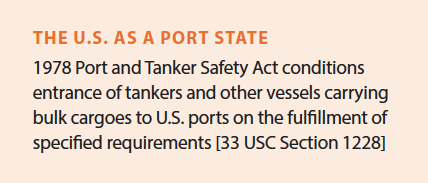 Port States have the right to enforce compliance with national rules and standards as a condition for the entry of foreign vessels into their ports, internal waters, and offshore terminals.25 Under MARPOL, these States have been entrusted with the additional right to “enforce applicable international rules and standards” in other States’ maritime zones and on the high seas in the case of an illegal operational discharge. Port States can thus prevent severe pollution damage to the marine environment that could be caused by substandard ships. Port States indirectly act in the interest of the international community as well because marine pollution does not stop at man-made maritime boundaries.26 In practice, Port States can refrain from exercising their enforcement powers effectively since these are voluntary. Some factors such as cost-benefit analysis, the fear of a competitive disadvantage, and the lack of political will in the absence of national interest come into play. Port States in different parts of the world have set up regional control regimes.27
Port States have the right to enforce compliance with national rules and standards as a condition for the entry of foreign vessels into their ports, internal waters, and offshore terminals.25 Under MARPOL, these States have been entrusted with the additional right to “enforce applicable international rules and standards” in other States’ maritime zones and on the high seas in the case of an illegal operational discharge. Port States can thus prevent severe pollution damage to the marine environment that could be caused by substandard ships. Port States indirectly act in the interest of the international community as well because marine pollution does not stop at man-made maritime boundaries.26 In practice, Port States can refrain from exercising their enforcement powers effectively since these are voluntary. Some factors such as cost-benefit analysis, the fear of a competitive disadvantage, and the lack of political will in the absence of national interest come into play. Port States in different parts of the world have set up regional control regimes.27
Enforcement Jurisdiction Matrix
Enforcement conclusion
There are competing principles which States must weigh concerning issues of enforcement of the LOSC. A balance needs to be struck between controlling pollution and ensuring freedom of navigation in the high seas and between the jurisdictions of flag States versus that of coastal States.
Environmental Laws and Maritime Security
In some cases, competing security and environmental priorities can create potential tensions, and reveal areas of compromise and cooperation. Natural resource protection and national security concerns both have a place in the oceans because both contribute to the welfare of the U.S. and other States.
Many States, including the U.S., have adopted marine environmental regulations including marine protected areas and similar laws. Recognizing the importance of marine resource protection, some believe these laws may have the potential to be used to curtail freedom of navigation in affected waters. By the same token, the U.S. has successfully used marine protections to exclude foreign fishing vessels in areas like the New England coast. This has prevented overfishing by foreign States. Environmental laws may alter the respective rights and responsibilities of flag, coastal, and port States under the LOSC. However, as demonstrated above, the LOSC incorporated accommodations for regional actors to fit within a larger system of cooperation.
The Marine Mammals Protection Act (MMPA) serves as a good example of balancing environmental and security interests. Congress created MMPA to protect marine mammals from “extinction or depletion.”28 A recent case from the 9th Circuit Court of Appeals, NRDC v. Pritzker, illustrates tensions that surface with different uses of the sea. The case was brought by the National Resources Defense Council (NRDC) in response to the National Marine Fisheries Service’s (NMFS) oversight of low frequency sonar use by the military. Sonar might affect marine mammal migration, reproduction, surfacing, nursing, feeding, and sheltering. The NRDC claimed the current use of sonar harmed marine mammals in ways that were illegal under the MMPA. The U.S. Navy argued that stringent regulations on the part of the NMFS could jeopardize sonar use important to national defense.B
The Ninth Circuit Court of Appeals ruled in favor of the NRDC, finding that the NMFS had not met it statutory duty to demonstrate that its regulations regarding low frequency sonar provided for the “least practicable adverse impact” on marine mammals. The Court noted that the MMPA concerns peacetime use of sonar and that its ruling does not “constrict the Navy’s operations during a war or active military engagement.” This case shows the challenges in balancing the interests of multiple stakeholders in the use of the ocean, including, in this instance, the tension between national security interests and natural resource protection.
Conclusion
The oceans can be exploited for financial gain, are centers of scientific inquiry, and provide inspiration for many people. The LOSC provides the first low-stakes protection for the marine environment in a global convention. Written in language that largely calls States to duties, rather than obligations, the LOSC asks States to reflect on their own environmental impact, their influence on others, and how partnerships can be formed to study and respond to pollution. A keystone of global environmental governance, the LOSC protects the equilibrium of the world’s oceans, and preserves access to the primary sources of food for over one billion people.29
- WWF, “Oceans Valued at 24 Trillion”, April 22, 2015, (available at http://www.worldwildlife.org/stories/ocean-assets-valued-at-24-trillion-but-dwindling-fast).
- U.S. Department of State, “Marine Biodiversity”, (available at http://www.state.gov/e/oes/ocns/opa/biodiversity/index.htm).
- National Geographic, “One of the World’s Largest Fisheries is on the Verge of Collapse, August 29, 2016, (available at http://news.nationalgeographic.com/2016/08/wildlife-south-china-sea-overfishing-threatens-collapse/).
- United Nations Convention on the Law of the Sea, Article 192, Dec. 10, 1982, 1833 U.N.T.S. 397 [hereinafter LOSC]. (available at: http://www.un.org/depts/los/convention_agreements/texts/unclos/part2.htm).
- LOSC, Article 194(1).
- LOSC, Article 196(1).
- LOSC, Article 194(2).
- See, e.g., LOSC, Articles 200-202.
- The New York Times, “Tribunal Rejects Beijing’s Claims in the South China Sea”, July 12, 2016, (available at http://www.nytimes.com/2016/07/13/world/asia/south-china-sea-hague-ruling-philippines.html).
- United Nations, “Convention on the Law of the Sea: Protection of the Marine Environment”, 2012 (available at: http://www.un.org/depts/los/ convention_agreements/convention_historical_perspective.htm).
- NOAA, “What is the Biggest Source of Pollution in the Ocean?”, May 25, 2015, (available at http://oceanservice.noaa.gov/facts/pollution.html).
- IMO, Status of Conventions (printed on 11.01.2017).
- Decision Nos. 07-87362 & 07-87931, Cour de Cassation (chamber criminelle), May 5, 2009 14
- Z.O.Ozcayir, Liability for Oil Pollution and Collisions (Lloyds of London Press, 1998), pp 16-19 15
- LOSC, Article 217(8).
- LOSC, Article 211(1).
- LOSC, Article 217(2-7).
- OGSR, “Liberia”, (available at https://www.guidetoshipregistries.com/sample/liberia); See also United Nations, “Convention on the Law of the Sea”, 2012, (available at http://www.un.org/depts/los/convention_agreements/convention_historical_perspective.htm).
- Liberian Registry, “About the Liberian Registry”, 2016, (available at http://www.liscr.com/liscr/AbouttheLiberianRegistry/tabid/197/Default.aspx).
- LOSC, Article 211(6).
- LOSC, Article 21(2).
- LOSC, Article 220(1).
- LOSC, Article 224.
- LOSC, Article 230.
- ‘Fast Independence’ and ‘Trans Artic’ Cases, Cour de cassation [French Court of Cassation] 07-87363, 07-97931, 5 May 2009, reported in (2009) Bull
Crim No 85. - LOSC, Article 211(3).
- Doris Konig, “The Enforcement of the International Law of the Sea by Coastal and Port States”, Max Planck Institute, p.5. (available at http://www.zaoerv.de/62_2002/62_2002_1_a_1_16.pdf ).
- Doris Konig, “The Enforcement of the International Law of the Sea by Coastal and Port States”, Max Planck Institute, p.7. (available at http://www.zaoerv.de/62_2002/62_2002_1_a_1_16.pdf ).
- U.S. Fish and Wildlife Service, “Marine Mammal Protection Act”, April, 3-, 2004, (available at https://www.fws.gov/International/pdf/legislation- marine-mammal-protection-act.pdf ).
- Nat. Res. Def. Council, Inc. v. Pritzker, 828 F.3d 1125 (9th Cir. 2016).
- CIERP, “Charting a New Course for the Oceans”, April 2014, (available at http://fletcher.tufts.edu/~/media/Fletcher/Microsites/CIERP/Publications/2014/Fisheries_14_Doc.pdf ).
A. ‘FastIndependence’ and ‘Trans Artic’ Cases, Cour de cassation [French Court of Cassation] 07-87363, 07-97931, 5 May 2009, reported in (2009) Bull Crim No 85.
B. Nat. Res. Def. Council, Inc. v. Pritzker, 828 F.3d 1125 (9th Cir. 2016).
